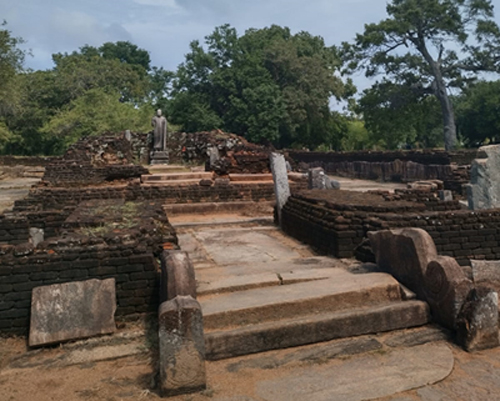Trinco’s old monastery where Sinhalese and Tamils worshipped

Standing alone: The Buddha statue at the site
Lost in ancient Gokanna (present-day Trincomalee) is Velgam Vehera, the remains of a Buddhist monastery where once Tamils as well as Sinhalese worshipped amidst the dry, salt-tinged jungle tide.
To get to these ruins, one turns off the isolated Trincomalee–Horowpothana road and travels the four kilometres through half wilderness, stopping to partake of plain tea with jaggery at a roadside kade.
Your first sight is of a garish modern temple, with a small bell-like white stupa and new outbuildings which serve the villagers today.
But the antiquarian’s path leads off the beaten track to the pleasing jungle – a sanctuary of ancient brickwork and stone that speak of the ruined glories of the Anuradhapura and Polonnaruwa periods when some of our loftiest princes must have given patronage to this place.
Here today macaque and langur hold court permanently, where more surprises await the archaeologist, below ground as well as within thick jungle.
Visible are a scattered dagoba and solemn image houses, as well as stone baths and inscriptions etched in Tamil and Sinhala.
The secret of Velgam Vehera’s uncanny thriving in the Eastern province, is that Tamils, including the Chola invaders who called it Rajaraja Perum Palli after their emperor, the indomitable ‘king of three crowns’, aslo worshipped here.
It was never razed to the ground and pillaged unlike many others and the Tamil inscriptions show moreover that it was richly rewarded and bequeathed. A worthy called ‘Adittappera-raiyan’ for instance gifted 84 cows for the purpose of maintaining the perpetual lamps; and a sacred perpetual lamp was donated by Eranadan Yakkan.
The solitary Buddha statue stands in the heart of the complex – the sole human figure in the serene landscape. Was it there from the time of Devanampiyatissa when it is supposed the vihara was founded at the beginnings of the Aryan civilization in Lanka?
Amidst kings who gave lavish patronage to this monastery later, are Bathiya I, Agbo II, Vijayabahu I and Parakramabahu I.
When the Department of Archaeology began their digs in the 1950s, two large mounds proved to be particularly intriguing. One turned out to be the stupa, with a diameter of 36 and a half feet at the base; it had been decorated profusely with bricks with ornamental designs, terracotta figures and elaborately carved coral stones.
The other mound was the image house, which, as redecorated by the Cholas, had various South Indian embellishments including Dravidian mouldings at the base.
There is also a building which had housed a recumbent Buddha. The outline of the old statue still undulates in a clear silhouette. Going by the bricks used, this and the main shrine must have been both built in the 11th or 12th Century.
The sense of mystery in the place- with these silent but eloquent carved stone and brick and mound is strong.
Searching for an ideal partner? Find your soul mate on Hitad.lk, Sri Lanka's favourite marriage proposals page. With Hitad.lk matrimonial advertisements you have access to thousands of ads from potential suitors who are looking for someone just like you.


